Tiny particles in blood useful for early diagnosis of pancreatic cancer
A protein encoded by the gene glypican-1 (GPC1) present on cancer exosomes may be used as part of a potential non-invasive diagnostic and screening tool to detect early pancreatic cancer, potentially at a stage amenable to surgical treatment, according to a study [1] at The University of Texas MD Anderson Cancer Center.
Exosomes – tiny, virus-sized particles released by cancer cells, contain DNA, RNA and proteins. Scientists isolated and monitored GPC1-enriched circulating exosomes from the blood of pancreatic cancer patients, termed GPC1+ crExos.
“GPC1+ crExos were detected in small amounts of serum from about 250 patients with pancreatic cancer with absolute specificity and sensitivity, importantly distinguishing patients with chronic pancreatitis from those with early- and late-stage pancreatic cancer,” said Raghu Kalluri, M.D., Ph.D., chair of Cancer Biology.
Levels of GPC1+ crExos were significantly lower in patients following surgical removal of the tumor, said Kalluri, whose study results are published in the June 24, 2015 issue of Nature. The study examined crExos from healthy donors and breast and pancreatic cancer patients. Elevated GPC1+ crExos were seen in both cancers.
“GPC1+ crExos can be detected and isolated in blood samples that were stored in freezers almost 30 years ago, unlike circulating tumor cells (CTCs) that require large amounts of fresh blood,” said Kalluri. “DNA, RNA and proteins can be isolated from cancer exosomes isolated from stored specimen for further genetic and biological analyses. Therefore, cancer exosomes are not just a biomarker but isolating them provides a trove of cancer specific information.”
GPC1+ crExos appear to be a more reliable screening tool than the commonly used CA 19-9 biomarker. The study found that GPC1+ crExos detected the possibility of pancreatic cancer in mouse models of pancreatic cancer at a time when the mice showed no signs of pancreatic disease by MRI.
“Routine screening of the general population for pancreatic cancer using MRIs or CTs would be prohibitively expensive with the likelihood for many false positives,” said David Piwnica-Worms, M.D., Ph.D., chair of Cancer Systems Imaging, “Our study suggests the potential for GPC1+ crExos as a detection and monitoring tool for pancreatic cancer in combination with imaging, with an emphasis on its application in early detection.”
“Because pancreatic cancer-specific genetics can be detected in these exosomes, there is great potential to enhance specificity of MRIs or CTs,” said Kalluri
If detected early, surgery involving a pancreatico-duodenectomy or the Whipple procedure can be curative for pancreatic cancer patients. Since pancreatic cancer is often diagnosed in the later stages, only about 15 percent of patients qualify for the surgery.
“Studies comparing stage of disease with outcome following surgery suggest that death rates for pancreatic cancer would be reduced if the disease were diagnosed at an earlier stage,” said Kalluri. “This presents an unprecedented opportunity for informative early detection of pancreatic cancer and in designing potential curative surgical options.”
Czech pancreatic cancer incidence rates rank 1st worldwide
According to the latest figures released by IARC [2], Czech pancreatic cancer incidence rates rank 1st both in Europe and worldwide (Fig. 1). Czech pancreatic cancer mortality rates nowadays rank 3rd globally and 2nd in Europe, when taking both sexes into account (Fig. 2). According to an expert estimate by the Institute of Biostatistics and Analyses of Masaryk University (IBA MU) [3], more than 2,300 new cases of pancreatic cancer will be diagnosed in 2015, and almost 1,600 of them will be diagnosed at an advanced stage, with metastases to other organs.
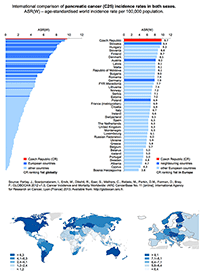 |
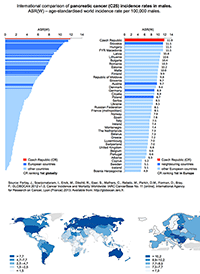 |
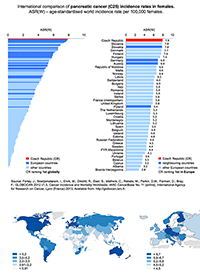 |
|
Figure 1: International comparison of pancreatic cancer incidence rates. |
||
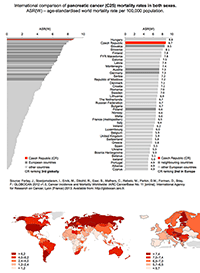 |
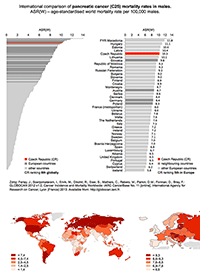 |
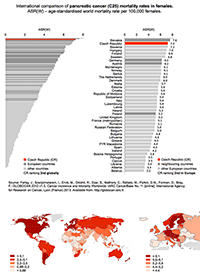 |
|
Figure 2: International comparison of pancreatic cancer mortality rates. |
||
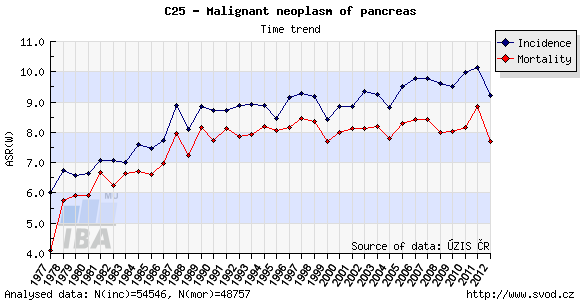
Figure 3: Pancreatic cancer incidence and mortality rates in the Czech Republic (both sexes), ASR-W. Data source: CNCR [4].
Reference
- Melo SA, Luecke LB, et al. Glypican-1 identifies cancer exosomes and detects early pancreatic cancer. Nature 2015. doi: 10.1038/nature14581
- Ferlay, J., Soerjomataram, I., Ervik, M., Dikshit, R., Eser, S., Mathers, C., Rebelo, M., Parkin, D.M., Forman, D., Bray, F.: GLOBOCAN 2012 v1.0, Cancer Incidence and Mortality Worldwide: IARC CancerBase No. 11 [online]. International Agency for Research on Cancer, Lyon (France) 2013. Available from WWW: http://globocan.iarc.fr.
- Dušek, L., Vyzula, R., Melichar, B., Abrahámová, J., Fínek, J., Petruželka, L., Vorlíček, J.: Číselné podklady pro plánování nákladů léčebné péče v onkologii – analýzy dostupných populačních dat a predikce pro rok 2015 [article in Czech]. In: Modrá kniha České onkologické společnosti. Brno: Masarykův onkologický ústav, 2015. 250–259. ISBN 978-80-86793-36-8.
- Institute of Health Information and Statistics of the Czech Republic: Czech National Cancer Registry (CNCR) [22. 7. 2015]. Available from WWW: http://www.uzis.cz/registry-nzis/nor
Keywords: glypican-1, exosomes, pancreatic cancer, early detection
24. 6. 2015 MD Anderson Cancer Center / Institute of Biostatistics and Analyses of the Masaryk University (IBA MU)



